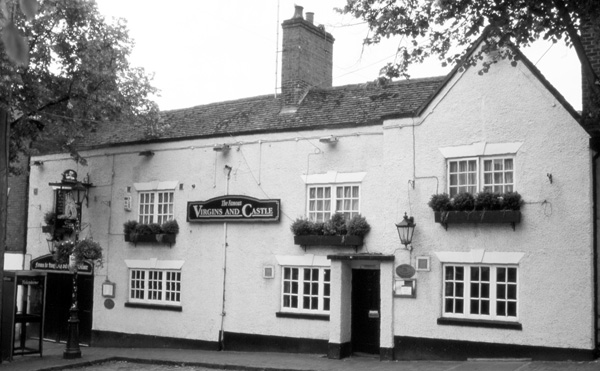How did the ‘Virgins & Castle’ get its name?
(First published in the KWN, 19th October 2007)

If one ignores the contrived names such as Fellis and Firkin and Tut and Shive, without doubt the most unusual, and probably unique, name a Kenilworth pub has carried is The Virgins Inn and Castle Tavern. It has long been suspected that the name arose from the amalgamation of two separate inns, but precisely how and when did it originate?
The Virgins and Castle can lay claim to being Kenilworth’s oldest pub, (known to have existed in 1563), and in June 1760 when its ownership passed to one John Brown it was known, as it had been from its earliest record, as The Two Virgins and was described as having “..a barn, stable, brew house, gardens and backside.” Upon Brown’s death, the inn passed to his brother-in-law John Ball, and later to William Ball; the Ball family were from Aston. In early 1825 the inn was in a poor condition – “The whole of the premises (are) in a very ruinous state for want of repair.” The following month, Ball received £400 from his brother in law, but it is not clear if this was for a mortgage or repairs.
By 10th October 1826, Abel Miles had become the licensee and on Boxing Day that same year he married Kenilworth girl Sarah Lenton at St.Phillips Church in Birmingham. This was an expensive Christmas for Miles as four days previously he had spent £290 on household furniture and brewing equipment, a very large sum considering a good weekly wage was then under £1. The following year, with the pub now in a better state of repair and with a new licensee in place, the name was changed to The Castle Tavern, and in January 1831 ownership of the inn was conveyed from William Ball to Abel Miles.
Miles had a degree of financial success. During his time at The Castle Tavern he bought five nearby cottages which were alongside The Vicarage, two cottages in Albion Row(Street) and a two acre field with a trackway leading from it to Pipers Lane (part of Whitemoor Road).
By the 1850’s Abel Miles’s health was failing, and on 3rd September 1851 he let The Castle Tavern on a seven-year lease to Thomas Pettifor who was married to Abel’s niece, Keren. Just five days later Abel died aged 52, and remarkably his wife Sarah outlived him by only twelve days; she was 55. Abel and Sarah lie together in St.Nicholas churchyard, beneath one of the sepulchral slabs unearthed from the Abbey ruins.
Under the terms of his will, Abel Miles’s property came up for auction on 11th May 1852, but during those few months Thomas Pettifor had also died, leaving his widow Keren as licensee. Her auction bid of £700 was successful. It is the documentation concerning the death of Abel Miles, and Keren’s successful bid, that contains the details confirming The Two Virgins and The Castle Tavern were the same premises. There are several documents containing the phrase “Castle Tavern (or Two Virgins)”, and an Abstract of Title stating “Castle Tavern, formerly the Two Virgins.” The auction poster itself refers to it as “The Virgins Inn and Castle Tavern” and so it would appear that it was the Pettifors between September 1851 and May 1852 who decided to amalgamate the two names. The conveyance to Keren Pettifor reverses the name to “Castle Tavern and Two Virgins” and a number of variations have been used over the years. Today it is simply The Virgins and Castle.
The documents from which above was extracted are to be found at Warwick Records Office, catalogue number CR556/819 The Probate of Alfred Miles.
Footnote:
This is an abbreviated form of the article The Two Virgins and a Man who was Abel, published in Kenilworth History 2002-2003.
Discover more about The Virgins & Castle and other Kenilworth pubs in Victorian Kenilworth & its People